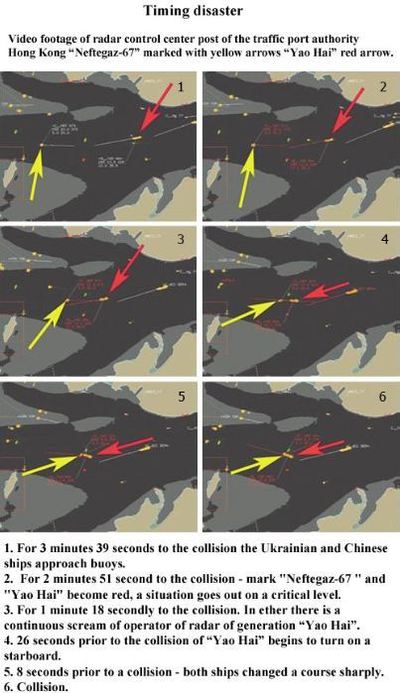
Illustration proposée par l'auteur.
The analysis of the casualty stated that Master of the “Neftegaz-67” was acting in compliance with Rule 17 of the Collision Regulations “The Stand-on Vessel”, while those onboard “Yao Hai” were acting in compliance with the Rule 9 “Narrow Channels”. And, at first sight, there were grounds for making such a conclusion: navigation along the fairway of a limited width (in other words, one can boldly speak of availability of narrow waters), marked with buoys, through which “Neftegaz-67” was passing eastward and where the bulk carrier “Yao Hai” was shaping to from the North-East…
Three years have passed since the collision. Over this time the case had been put to analysis by many experts who had different and at times polar opposite assessments. The trial is over and its results are quite ambiguous.
Today someone must admit, in view of information available about the collision in Hong Kong in my opinion the certain points made require clarification.
The first such a point is referred to navigation in a narrow channel. The narrow channel, which is actually … non-existent in that area (there are confined waters)! This means there are no grounds for mentioning Rule 9 of the Collision Regulations. None of the documents pertaining to description of the area specifies it as a narrow channel. Besides, there is no sufficient legal definition of a narrow channel. Thus, it is the mariners who shall determine when they are in a narrow channel and under common circumstances maneuver in compliance with Rule 9.
The second point is referred to the buoys. These do not mark a narrow channel again, but are set on the bathymetric contour of 20 meters. Thus, the buoys actually mark not even a channel, but just a deep water route for the vessels having the draft over 16 meters. The third point is that both vessels could safely navigate outside the line of the lowest points of depth (thalweg) (the draft of “Neftegaz-67” was 4,5 meters and the draft of “Yao Hai” was 12,5 meters). Based on this determination they were not obliged to be on the deep water route. However, as far as “Neftegaz-67” had already been proceeding along the deep water route, there was no need for the bulk carrier to approach “Neftegaz-67” until the distance between the vessels became dangerously close in the buoyed area.
The fourth point justifies “Neftegaz-67’s” proceeding close to the northern (port of the course line) limit of the deep water route. Such a movement might have been considered illogical, but it was dictated by the location of Prohibited Area No.6 around Siu Mo To Island. As “Neftegaz-67” had over 25 meters in height above the water line (15 meters allowed) she was to keep away form this Area and pass it along its northern limit. As a result “Neftegaz-67” found herself in the middle of the deep water route, rather than close to its starboard limit. Further on the AHTS was to maintain her course and speed in view of existence of a target on her port side (which was “Yao Hai”) in compliance with the Rule 17 “The Stand-on Vessel”.
Within 13 minutes from 21.00 until 21.13 the crossing situation had been developing between the two vessels (Rule 15). From a viewpoint of responsibility for the possible aftermath in the most unfavorable situation was the Chinese bulk carrier (Rule 16), which during almost entire time interval from the point when the vessels detected each other until the time of collision had been observing a vessel on her starboard bow, but failed to take any actions from her part to avoid the collision.
A number of experts made several attempts to consider the head-on situation, but, in our opinion that had the only purpose of allocation of responsibility for collision between the vessels, to be more exact to diminish the responsibility of the Chinese bulk carrier (Rule 14 “Head-on situations”). As a mere formality, the vessels collectively have breached the following Rules of Collision Regulations: 2, 5, 6, 7, 8, 15, 16, 17. However, the Rules which determine the responsibility for that what happened shall be Rule 15 of the Collision Regulations “Crossing Situation” and Rule 16 (“The Give-way Vessel”) which in our opinion the Chinese bulk carrier was not even trying to comply with, which is aggravating her responsibility for the casualty.
In conclusion we have to express our opinion on the “Yao Hai” actions: there is such an impression, that it had been doing its “homework” on creation of a dire emergency.
By Nikolay Kalanov, political scientist, author of 5 monographs and more than 40 publications on marine issues
Three years have passed since the collision. Over this time the case had been put to analysis by many experts who had different and at times polar opposite assessments. The trial is over and its results are quite ambiguous.
Today someone must admit, in view of information available about the collision in Hong Kong in my opinion the certain points made require clarification.
The first such a point is referred to navigation in a narrow channel. The narrow channel, which is actually … non-existent in that area (there are confined waters)! This means there are no grounds for mentioning Rule 9 of the Collision Regulations. None of the documents pertaining to description of the area specifies it as a narrow channel. Besides, there is no sufficient legal definition of a narrow channel. Thus, it is the mariners who shall determine when they are in a narrow channel and under common circumstances maneuver in compliance with Rule 9.
The second point is referred to the buoys. These do not mark a narrow channel again, but are set on the bathymetric contour of 20 meters. Thus, the buoys actually mark not even a channel, but just a deep water route for the vessels having the draft over 16 meters. The third point is that both vessels could safely navigate outside the line of the lowest points of depth (thalweg) (the draft of “Neftegaz-67” was 4,5 meters and the draft of “Yao Hai” was 12,5 meters). Based on this determination they were not obliged to be on the deep water route. However, as far as “Neftegaz-67” had already been proceeding along the deep water route, there was no need for the bulk carrier to approach “Neftegaz-67” until the distance between the vessels became dangerously close in the buoyed area.
The fourth point justifies “Neftegaz-67’s” proceeding close to the northern (port of the course line) limit of the deep water route. Such a movement might have been considered illogical, but it was dictated by the location of Prohibited Area No.6 around Siu Mo To Island. As “Neftegaz-67” had over 25 meters in height above the water line (15 meters allowed) she was to keep away form this Area and pass it along its northern limit. As a result “Neftegaz-67” found herself in the middle of the deep water route, rather than close to its starboard limit. Further on the AHTS was to maintain her course and speed in view of existence of a target on her port side (which was “Yao Hai”) in compliance with the Rule 17 “The Stand-on Vessel”.
Within 13 minutes from 21.00 until 21.13 the crossing situation had been developing between the two vessels (Rule 15). From a viewpoint of responsibility for the possible aftermath in the most unfavorable situation was the Chinese bulk carrier (Rule 16), which during almost entire time interval from the point when the vessels detected each other until the time of collision had been observing a vessel on her starboard bow, but failed to take any actions from her part to avoid the collision.
A number of experts made several attempts to consider the head-on situation, but, in our opinion that had the only purpose of allocation of responsibility for collision between the vessels, to be more exact to diminish the responsibility of the Chinese bulk carrier (Rule 14 “Head-on situations”). As a mere formality, the vessels collectively have breached the following Rules of Collision Regulations: 2, 5, 6, 7, 8, 15, 16, 17. However, the Rules which determine the responsibility for that what happened shall be Rule 15 of the Collision Regulations “Crossing Situation” and Rule 16 (“The Give-way Vessel”) which in our opinion the Chinese bulk carrier was not even trying to comply with, which is aggravating her responsibility for the casualty.
In conclusion we have to express our opinion on the “Yao Hai” actions: there is such an impression, that it had been doing its “homework” on creation of a dire emergency.
By Nikolay Kalanov, political scientist, author of 5 monographs and more than 40 publications on marine issues










 Les dernières actus de Chine
Les dernières actus de Chine








